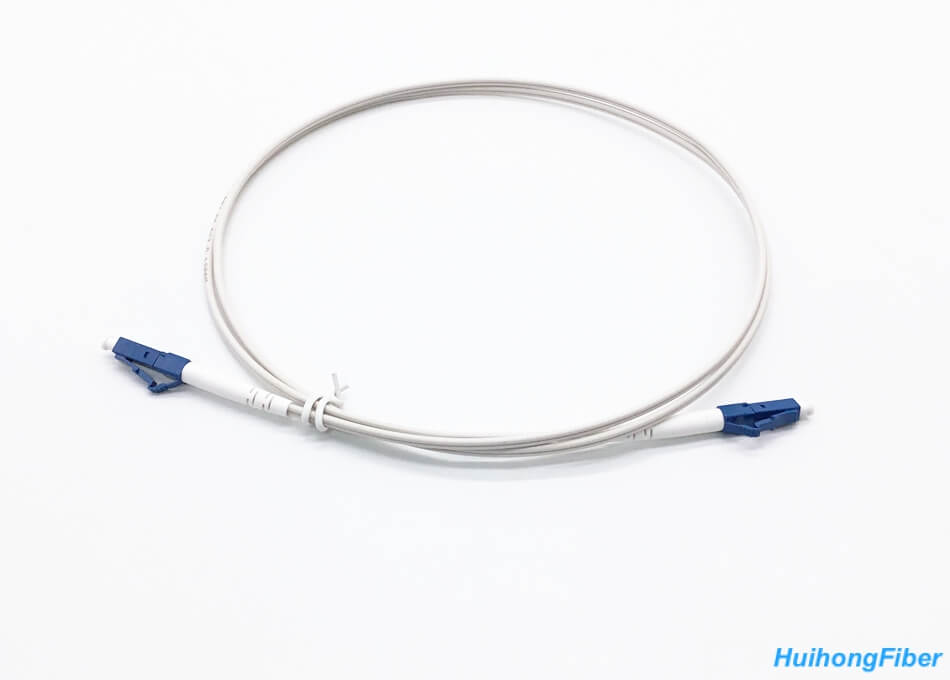With the increasing demand for high-capacity and long-distance transmission, FTTH (fibre-to-home) has become the preferred mode of broadband access. We know that in FTTH cabling must use FTTH indoor fiber jumper, this fiber-optic jumper not only has the advantages of high transmission quality, good reliability, low maintenance cost, anti-electromagnetic interference, but also has practical functions such as rodent, lightning protection, waterproofing, so it is widely used.
Specifications
| Connector Type | LC to LC | Polish Type | UPC/APC |
| Fiber Mode | OS2 9/125μm | Wavelength | 1310/1550nm |
| Insertion Loss | ≤0.3dB | Return Loss | ≥50dB |
| Fiber Grade | G.657/G.652.D | Minimum Bend Radius | 10mm |
| Attenuation at 1310 nm | 0.36 dB/km | Attenuation at 1550 nm | 0.22 dB/km |
| Fiber Count | Duplex | Cable Diameter | 2.0mm |
| Cable Jacket | PVC | Polarity | A(Tx) to B(Rx) |
| Operating Temperature | -20~80°C | Storage Temperature | -40~80°C |
G.652D is the fiber-optic fiber model in fiber optic cable, representing the non-dispersion displacement single-mode fiber, is currently the most widely used single-mode fiber. Commercially launched in 1983, its scattered wavelength at 1310nm, at 1550nm at the minimum attenuation, but there is a larger positive dispersion, about 8ps (nm/km), the working wavelength can be selected 1310nm, can also choose 1550nm.
This fiber is the most widely used fiber, most of the fiber has been laid, fiber optic cable is most of this kind of fiber. In the late 1970s, attempts were made to replace light-emitting diode light sources with developed long-life semiconductor lasers to obtain longer communication distances and greater communication capacity, but pattern noise occurs when lasers are transmitted in multimode optical fibers. In order to overcome the mode noise, in 1980 successfully developed a single-mode fiber (non-dispersive displacement single-mode fiber), referred to as standard single-mode fiber, which ITU-T recommends as G.652 fiber. Because the design idea of single-mode fiber is to transmit only one mode, there is no mode noise that occurs when transmission occurs in multimode fiber. Therefore, in the mid-1980s, 140Mbit/s optical fiber communication system consisting of laser light source and standard single-mode fiber, in which the relay distance and transmission capacity far exceeded the transmission system of coaxial cable, so that the optical fiber communication system gradually replaced the copper cable communication, becoming the main communication mode adopted in the telecommunications industry.
The G.657 access network with bending attenuation insensitive single-mode fiber optic cable characteristics” is the standard that ITU-T issued in November 2006.
G.657 Fiber is the latest fiber variety developed based on G.652 fiber to achieve the goal of fiber-to-the-home. The main characteristic of this type of fiber is its excellent bending resistance, which achieves a bending radius of 1/4 to 1/2 of the conventional G.652 fiber. G.657 fiber sub-A, B two subcategories, in which G.657A fiber performance and its application environment and G.652D type fiber similar, can be in the 1260 to 1625nm wide wavelength range (i.e. O, E, S, C, L5 working bands) work The G.657B fiber mainly works at 1310nm, 1550nm and 1625nm 3 wavelength windows, which is more suitable for the transmission of FTTH information, installation in the interior or building and other narrow places.
FTTH indoor fiber optic LC cables have a variety of features and advantages, as follows:
FRP reinforcement – excellent anti-pressure performance.
FTTH indoor fiber optic LC cable has a unique “8” type design, there are two parallel FRP reinforcements, can make fiber optic cable has good pressure resistance, and can protect fiber optic, and truly achieve low insertion loss , low smoke halogen-free flame retardant sheath , more environmentally friendly and safe.
Full-media structure – free from electromagnetic interference.
FTTH indoor fiber LC cable can connect fiber directly to the user’s home, its broadband, wavelength and transmission technology categories are not limited, but also can introduce a variety of new services, as the ideal transparent network, is the final way to access the development of the network.
FTTH indoor fiber LC cable is widely used in LAN, fiber optic communication system, CATV, FTTH indoor building, fiber optic connection, transmission equipment and access network.
Soft and flexible, but also good waterproof and flame-retardant properties, and two FRP strength components to ensure anti-electromagnetic and anti-crushing good performance;
Very practical, but also has a special low-bend sensitivity fiber to provide high bandwidth and excellent performance; Simple structure, light weight, novel flute design, easy to peel and stitch, maintenance is very simple。

